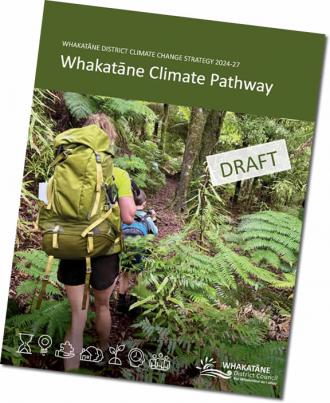The climate is changing. It's incredibly complex and at times overwhelming. It's already affecting our weather, health and wellbeing, natural environment, taonga species, mahinga kai, food production, biosecurity, infrastructure, and the economy.
We can't solve it with just one solution, but lots of small actions make a difference.
 What's happening now?
What's happening now?
We're currently reviewing our Climate Change Strategy and we want to hear from you!
Draft Whakatāne District Climate Change Strategy 2024-27 - Whakatāne Climate Pathway - (PDF, 3.36 MB)
Responding to the impacts of climate change on the District and doing our bit to reduce future climate change is the responsibility of each of us, individually and collectively. We have been on a journey, collaborating to develop a draft Whakatāne District Climate Change Strategy - Whakatāne Climate Pathway, that carves a pathway to work together to shape sustainable, low-emission, climate resilient communities.
Thank you for your interest, consultation closed at 5 pm, Friday 12 April.
Information to support the Whakatāne Climate Pathway
Climate Actions
The development of a new climate response for the district involved input from many sources, including the community. Whilst key actions are identified in the Climate Pathway document, there are many other actions that, collectively, we can work towards as a District. Some of these actions sit with Council, while others don't. Some are supported with funding, while others will only progress if funding becomes available. But together they represent a comprehensive list of actions that we can all deliver, which can be updated and added to overtime, to guide our District's response to climate change.
Climate Actions - (PDF, 567 KB)
Climate Targets
The Whakatāne Climate Pathway includes targets for how we will transition to a low emission community. These targets are based on the Climate Change Commission’s Demonstration Pathway. This document outlines the carbon footprint for both the Whakatāne District and the Council, how they have tracked in recent years, and how emissions need to track to achieve the targets defined in the Whakatāne Climate Pathway.
Climate Targets - Fact Sheet - (PDF, 1.2 MB)
Regional Risk Assessment
Bay of Plenty Regional Council has commissioned a Regional Risk Assessment. This information is a critical part of understanding the implications of Climate Change for our region. We will be developing a District Risk Assessment over the coming year, but in the meantime, this regional assessment provides valuable data.
Visit boprc.govt.nz to read the 'Regional risk assessment' »
Read more information about climate change in the Whakatāne District »
